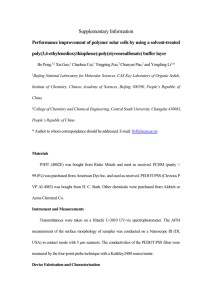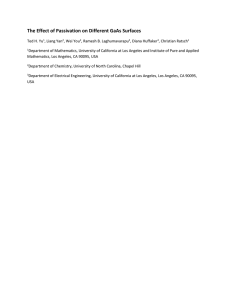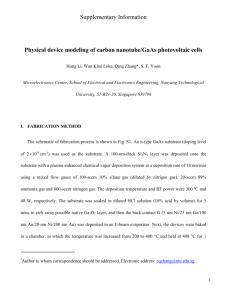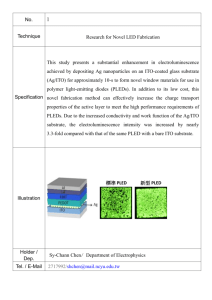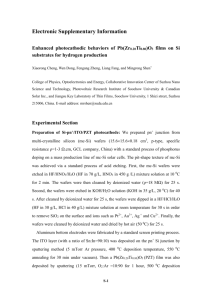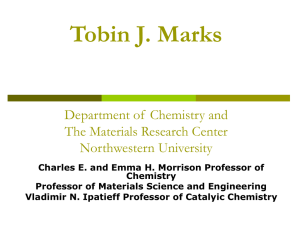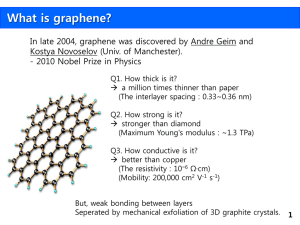Sol LiF devices supporting information 01.06.2012
advertisement
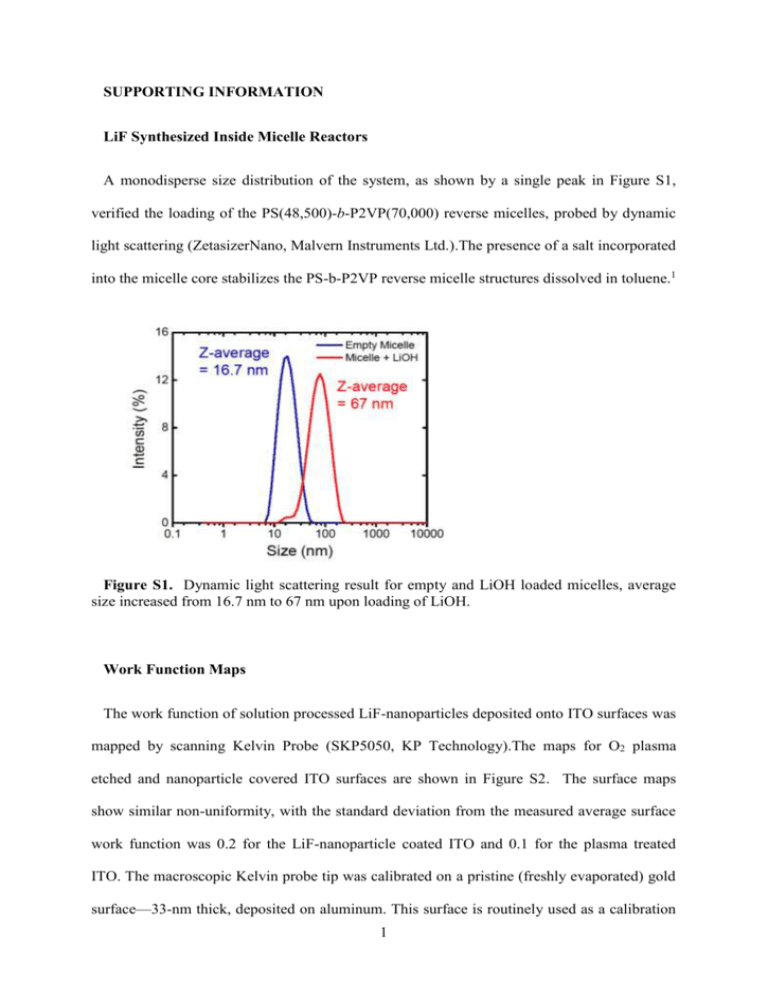
SUPPORTING INFORMATION
LiF Synthesized Inside Micelle Reactors
A monodisperse size distribution of the system, as shown by a single peak in Figure S1,
verified the loading of the PS(48,500)-b-P2VP(70,000) reverse micelles, probed by dynamic
light scattering (ZetasizerNano, Malvern Instruments Ltd.).The presence of a salt incorporated
into the micelle core stabilizes the PS-b-P2VP reverse micelle structures dissolved in toluene.1
Figure S1. Dynamic light scattering result for empty and LiOH loaded micelles, average
size increased from 16.7 nm to 67 nm upon loading of LiOH.
Work Function Maps
The work function of solution processed LiF-nanoparticles deposited onto ITO surfaces was
mapped by scanning Kelvin Probe (SKP5050, KP Technology).The maps for O2 plasma
etched and nanoparticle covered ITO surfaces are shown in Figure S2. The surface maps
show similar non-uniformity, with the standard deviation from the measured average surface
work function was 0.2 for the LiF-nanoparticle coated ITO and 0.1 for the plasma treated
ITO. The macroscopic Kelvin probe tip was calibrated on a pristine (freshly evaporated) gold
surface—33-nm thick, deposited on aluminum. This surface is routinely used as a calibration
1
surface. The value was measured in air, under controlled Relative Humidity (RH) conditions,
typically 40-42% RH and 293 K. The samples were measured under identical conditions.
Figure S2. Maps of the surface work function as measured by scanning Kelvin probe for (a)
a single deposition of LiF, after etching with O2 plasma; and for (b) O2 plasma etched ITO.
Note that the apparent regular pattern of high Ф at 2 mm is uncorrelated with the pattern of
LiF-nanoparticle dispersion on the surface, and the surface variation in work function is
similar for both cases.
Sheet Resistance
The sheet resistance of the ITO films with and without the LiF-nanoparticles was measured
by 4-point probe, with the deviations from bare ITO summarized in Table SI. The pogo-pin
probe tips (Interconnect Devices, Inc.) were ~0.5 mm in diameter, contacting areas of the
sample surface that would encompass the influence of many LiF-nanoparticles. Because the
difference in sheet resistance for the LiF-coated samples was below the 20% error quoted by
2
the manufacturer, it can be concluded that the LiF particle surface coverage is of too low a
density to impact the sheet resistance of the ITO.
Table SI. Change in sheet resistance values for coated ITO surfaces
Sample
ITO
14.1% LiF
29.3% LiF
Deviation from
bare ITO
0
-0.00769
-0.00499
% difference
--6%
-4%
Dark current J-V characteristics
Figure S3 shows the dark current characteristics for the various buffer layers.
(a)
(b)
Figure S3. (a) Schematic of OPV device layout showing the electrode configuration. (b)
Current density-voltage characteristics for devices with various interlayers under dark
conditions
The high current rectification ratios (105 and 104 for the control device and devices with
LiF-nanoparticles respectively) at ±1V indicate that the LiF-nanoparticles do not significantly
short the electrical junction across the device. The introduction of LiF-nanoparticles also leads
to higher currents under forward bias, suggesting better movement of charge across the
device. With the nanoparticles alone, there is a significant increase in the available current at
modest forward bias (<0.4V), where the current is limited by injection and recombination
3
(following the Shockley-Read-Hall formalism). This observation suggests that the energy
barrier between the active layers and the ITO has been decreased, allowing more charge
carriers to undergo recombination events. The observed ideality factor in this region, ndark, is
consistent with previous reports of P3HT:PCBM cells,2 and is almost identical for the devices
that include PEDOT:PSS. The slight decrease in the ideality factor closer to that dominated by
bimolecular recombination in PCBM3-4 for the LiF-nanoparticles alone i) suggests that the
deep traps originate in the PEDOT:PSS layer, and ii) explains why the developed current at
low voltages is lower with PEDOT:PSS incorporation into the device. Therefore, introducing
LiF-nanoparticles at the interface has no impact on the recombination ability of the system; its
major role is to enhance the flow of more charge carriers.
This finding is also supported by the higher observed saturation current in the space-charge
limited region (>0.5V) with LiF-nanoparticles, without significant change in the ideality
factor, m (derived from the slope of the curve in SCLC region). The observed ideality factors
for the space charge region are all in the range that suggests these devices are governed by
trap-dependent space charge-limited conduction,5 with a trap density ~1019 cm-3. Although the
difference in the measured factors is not very large, it does suggest that the trap density is
lowest without the PEDOT:PSS layer. The presence of LiF-nanoparticles does appear to
decrease the trap-density slightly, though the mechanism by which this occurs is not clear.
Table SII. Derived Shockley ideality (ndark), SCLC ideality (m) and rectification ratios (RR)
from the diode J-V results in dark
sample
ndark
m
RR
sol-LiF
1.43
3.7±0.07
6.2 x104
sol-LiF/PEDOT
1.69
3.9±0.05
2.0 x104
PEDOT
1.70
4.5±0.09
2.9x105
4
Shunt and Series Resistance
Real solar cells can be described with the equivalent circuit shown in Figure S4, described
by Equation 1.
qV Rs J V Rs J
J J ph J o exp
1
Rsh
nk BT
(1)
Figure S4. Equivalent circuit (single diode) model of a solar cell
The parasitic resistances, both shunt (Rsh) and series (Rs), can reduce the effective power
conversion efficiency. In modeling the device behaviour, it is common to use graphical
methods based on a plot of the derivative of the equivalent circuit diode model, given by
Equation 2.
dV
dJ
nk BT
q
V R J J nk BT
s
sc
q
J sc J
Rsh
Rs
(2)
The shunt resistance can be determined directly from the slope of the J-V curve at Jsc=0,
assuming Rsh>>Rs which is generally valid. (Equation 3)6{Ishibashi, 2008 #94,7.
dV
dJ
(3)
Rsh Rs Rsh
J J sc
5
There are a variety of techniques to determine the series resistance.8 Though a common
approach for mature silicon cells is to neglect the shunt resistance when assessing the series
resistance,9 this is typically not valid for organic systems. To eliminate the errors that can
occur for multiple measurements of the device performance, at different illuminations or at
different temperatures, we chose the method of Ishibashi et al.,7 which relies on a single
constant illumination J-V measurement to extract the parameters, and explicitly includes Rsh.
This approach has been effectively applied to organic solar cells, where the derived
parameters fit the experimental data quite well. The method of Ishibashi et al. is an iterative
approach to simultaneously fitting the series resistance (Rs) and ideality values (n), using
dummy values (Rso and no) as place holders in the derivative equation:
dV
dJ
nk B T
q
V R J J nk B T
s
sc
q
1
J sc J
Rsh
Rs
(4)
Rs Rso J sc J n no k BT q
nk T
V Rso J sc J o B
q
When the dummy values converge on the real values (i.e. <<1), the system can be described
by the dummy values in place of the real ones in Equation 2.
Following from this description, Rs is derived from the y-intercept and n from the slope of the
derivative plot as shown in Figure S5b. As a first step, the dummy values are set at 0, and the
extracted Rs and n values are used in the next iterative step as Rso and no. If the condition
<<1 is satisfied, the derived parameters are used to simulate the J-V curve. Optimal
parameters are derived by repeating the estimation for various values of Rsh until the mean
square error between the calculated J-V curve and the experimental data are minimized.
6
Figure S5. (a) Current density-voltage characteristics of P3HT:PCBM solar cell under
constant illumination at 100 Cd/m2. (b) Derivative curves of the linearized function with
linear fit to experimental data, where Rso=Rs and no=n
In our case, the numerical derivative of the discrete data values was determined as the
interpolated linear average of three adjacent points:
dV
dJ
V Vi , J J i
1 Vi 1 Vi Vi Vi 1
2 J i 1 J i J i J i 1
(5)
Other approaches, using the linear portion of the illuminated J-V curve6 or the dark J-V
curve10 at high V, gave inconsistent results, with values of the series resistance differing by
orders of magnitude and the derived parameters not accurately modeling the device
performance.
1
O. El-Atwani, T. Aytun, O.F. Mutaf, V. Srot, P.A. van Aken, and C.W. Ow-Yang,
Langmuir 26, 7431 (2010).
2
W.J. Yoon and P.R. Berger, Appl. Phys. Lett. 92, 013306 (2008).
7
3
G.A.H. Wetzelaer, M. Kuik, M. Lenes, and P.W.M. Blom, Appl. Phys. Lett. 99,
153506 (2011).
4
L.J.A. Koster, V.D. Mihailetchi, R. Ramaker, and P.W.M. Blom, Appl. Phys. Lett.
86, 123509 (2005).
5
G. Paasch and S. Scheinert, J. Appl. Phys 106, 084502 (2009).
6
A. Moliton and J.M. Nunzi, Polym Int 55, 583 (2006).
7
K.I. Ishibashi, Y. Kimura, and M. Niwano, J. Appl. Phys 103, 094507 (2008).
8
D. Pysch, A. Mette, and S.W. Glunz, Sol. Energ. Mater. Sol. Cells 91, 1698 (2007).
9
J. Nelson,The physics of solar cells. (Imperial College Press, London, 2003), p.15.
10
Y. Shen, K.J. Li, N. Majumdar, J.C. Campbell, and M.C. Gupta, Sol. Energ. Mater.
Sol. Cells 95, 2314 (2011).
8
